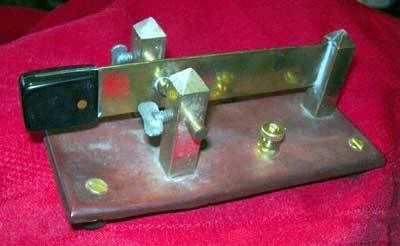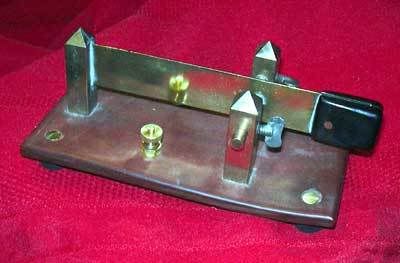As mentioned in my earlier post, I had more to jabber about but couldn't continue on until today.
While cleaning the shack recently, I ran across various pieces of eBay flotsam and jetsam that I've acquired … partly out of a sense of curiousity and partly out of a sense of duty. Duty? Yeah, when it comes to old, abandoned CW relics of the past, I figure that it's only fitting to try to breath a spark of life back into discarded old keys which would probably wind up unsold and in someone's landfill. Of course this sense of “duty” is coupled with the unspoken words “dirt cheap” as well.
My latest F&J restoration is a unusual CW key I picked up a couple of years ago. It's a commercially manufactured sideswiper — a “cootie key” if you will.

The key's parts are all brass, and are mounted on a bakelite base. One of the most common keying levers used on homebrewed sideswipers is a used hacksaw blade as they are easy to find and cheap. The keying lever for this sideswiper is a 1-inch brass blade that's approximately 5-1/2 inches long. The lever has a very nicely formed bakelite finger piece on the end. The keying lever is soldered to a post at the rear of the key.
The posts are rather unusual too. They are 1/2-inch square brass, and each is comes to a pyramind-style point. A square, snug-fitting recess was machined into the bakelite base to help give each post some additional support. The way the posts are finished give the key a decidedly gothic, medieval look (though I doubt The Knights of the Roundtable would have recognized the key for what it is).
I can't find the auction listing in my archive to illustrate how sad and forlorn this key looked. You couldn't tell the post and lever were brass; the base (which shows considerable dust and dirt) was a mess. The key was missing its four feet and the wiring terminals. It looked like one of those items that sellers leave in the hamfest trash can when it won't sell at the 'fest — most folks wouldn't take it for free. It wasn't free, but I don't recall anyone else bidding on it.

After the key arrived I spent a lot of time cleaning it, surprised to find brass beneath the grunge. I need to go back over it and give it a real detail polishing.
The contact posts have small wingnut-topped screws that tighten down to secure the contacts, which are nothing more than brass rods that pass through each contact post. You adjust the rod left and right to adjust the spacing you want, then tighten down the screw to hold it.
After I cleaned the key up, I researched it. To date I've not seen anything else like it in online collections anywhere. It might be a homebrew key, but I'm not yet convinced. The workmanship on the bakelite base still makes me believe it was a commerical piece. Maybe handcrafted by someone who knew what they were doing? Perhaps.
As you probably note in the photos, the bakelite base is warped. The base of the key curves upward right about the point where the contact posts are mounted. I've toyed with trying to flatten it again, but something tells me I'll wind up with a two-part (a “coo” and a “tie” key … hi!) key if I try that.
After I cleaned and polished up the brass, the key languished in the shack, getting shifted from one side to the other. It was “in-the-way” more often than not, and I finally put it a storage cabinet for safe keeping.
I needed to get some hardware for the key — mainly replacement feet and wire terminals. I figured Vibroplex replacement feet would work, I just needed to order them. With the key out of sight — and my Vibroplex keys needing feet worse — I never ordered parts for the sideswiper.
I recently ran across a guy selling quality rubber equipment feet on eBay. He had some small ones which were perfect for code keys, so I bought a bunch of them.
I bought the hardware to attach the feet to the sideswiper, along with some brass hardware to make my own wire terminals (a brass screw, brass nuts,washer and a knurled nut). The wire terminals came out looking better than I imagined they would. The added hardware gives the key some much-needed weight, too.
I'm still not convinced that this key wasn't originally attached to a heavier base. Perhaps a larger wooden base, or bakelite? Something that would be more appropriate for a sideswiper. You can't use the key now without holding onto it, otherwise it scoots around too much. These rubber feet hold it well, but sideswiper use jars a key around more than usual.
Using a sideswiper is a talent I've not fully acquired, but I've been trying. I can't get the knack of sending dits with the keying lever moving in either direction. I can use the key like a bug — make dits by moving the lever to the right and dahs to the left — but making my wrist (and brain) work the key like a true sideswiper is something that's going to take more practice.
It's an interesting key to use, even if I'm not perfectly “sideswiping” it. I can see where it would be preferable to a straight key, though manual dits would be tiresome.
There are a number of resources online regarding cootie or sidewiper keys. I'm tickled I finally got mine in operable shape. I don't know a date, but I suspect it would run in the 1920s-1930s. Most hams couldn't afford to spend $12 on a Vibroplex bug, but they could borrow their dad's hacksaw and make a cootie key.
The popularlity of cootie keys pretty much died after World War II … with all the surplus J-36 bugs that flooded the market, you could buy a new military bug for the price of a hacksaw. With cheap bug prices, no one really needed to homebrew their own bug …. not to mention the budding interest in the 1950s with electronic keying.
73 es CU AGN … de KY4Z … SK …. dit dit
UPDATE: After additiional practice, I used the sideswiper to check in to the KSN last night. It's still not a natural act to make the dits manually … I find myself trying to hold the keying lever and expect the dits to come automatically. Not with this key.
The key worked well with KSN, which isn't nearly as involved as trying to conduct a QSO. It was a good way to get my feet wet with the key. I had to send slowly and deliberately, but that's kind of in keeping with the KSN anyway. You don't check in at 30 words per on the “slow” CW net.
Band conditions were exceptionally good too. No problems copying all stations, though sometimes the net frequency being near the digital stations adds QRM.
Looking at the sideswiper, I realized if you ran that key on a old rig that put some healthy voltages out there on the key, you would wind up with quite a shock if you weren't careful how you held it. Time for a DC keying relay!
